AI in clinical trials will ripple through every segment, from medical devices to pharmaceuticals. Some forecasts predict the market for Artificial Intelligence in healthcare to increase more than 1000% between 2022 and 2029, stretching from $13.8 billion to $164.1 billion.
Each segment may harness AI to streamline processes, enhance precision, and accelerate time-to-market for innovative therapies.
As we navigate the infancy of AI in clinical research, we must take a responsible and measured approach. Here’s what to know about the current state of AI in clinical trials.
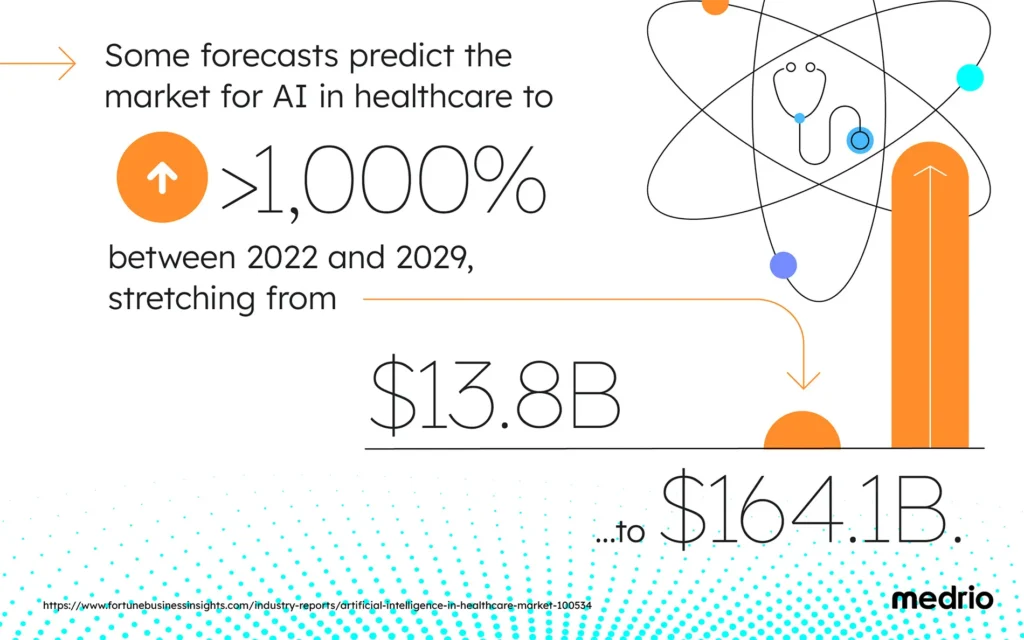
Want to learn more expert opinions on AI? Download Medrio’s ebook, “The State of AI in Clinical Trials.”
What is the Role of AI in Clinical Trials?
Artificial Intelligence (AI) refers to machines and algorithms programmed to mimic human cognitive functions. These functions may include problem-solving, pattern recognition, and decision-making.
In clinical research, AI may improve efficiency, trial design, data processing, and data analysis.
Current and Future Uses of AI in Clinical Research
AI in clinical trials may improve protocol design, recruitment, data handling, and more.
If used well, AI could reduce trial costs and support success rates. With many possible application areas, AI could reshape clinical trials from start to finish.
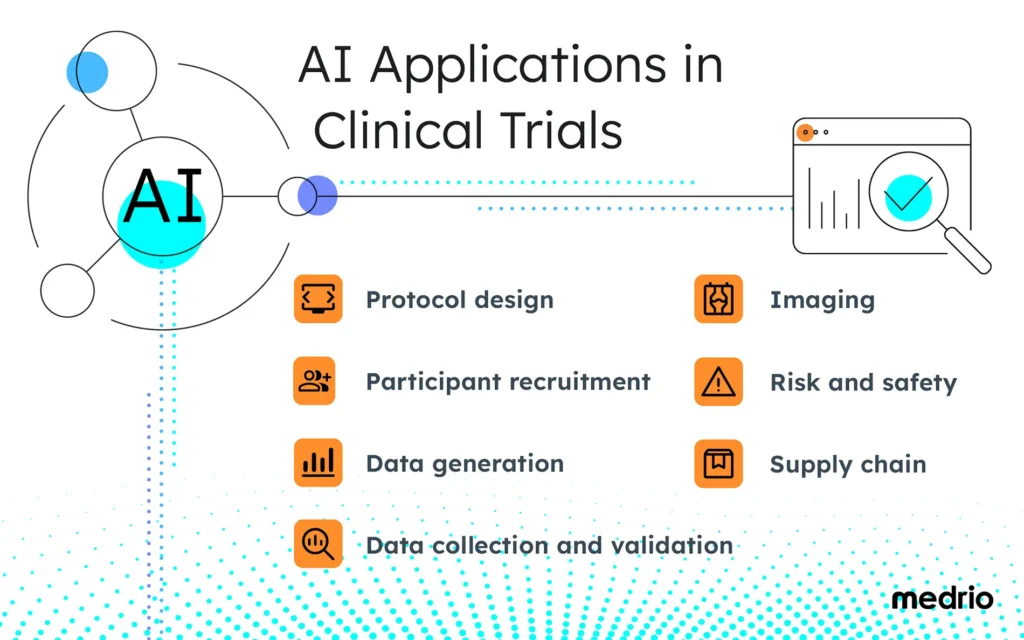
Possible applications of AI in clinical research include:
- Protocol design: AI could revolutionize protocol design by analyzing big datasets. These datasets can come from previous trials, patient records, and real-world evidence.
- Participant recruitment: AI could identify eligible patients using electronic health records. It could then match patients with trial criteria.
- Data generation: AI generates synthetic data for modeling and simulating trial scenarios. It can also train algorithms without compromising patient privacy.
- Data collection and validation: AI could eliminate human error in data entry and speed up the data cleaning process.
- Imaging: AI enhances the analysis of medical images in clinical trials.
- Risk and safety: AI could enable proactive risk monitoring and safety management in clinical trials.
- Supply chain: AI optimizes supply chain logistics by forecasting demand. It can also manage inventory and ensure the timely delivery of critical trial materials.
Explore more detailed use cases and information around each of these applications in our AI in Clinical Trials eBook.
Human-in-the-Loop Approach to AI
A human-in-the-loop (HITL) approach blends AI with human expertise. Experts supervise AI’s outputs, interpret insights, and make critical adjustments where needed.
A HITL approach ensures that AI-driven recommendations are correct, relevant, and ethical. The analytical power of AI plus human judgment improves efficiency and safety, keeping the human element at the forefront.
Implementing a HITL approach in clinical research requires defining clear checkpoints. These checkpoints note where human review is essential. For example, these checkpoints may be during certain stages of protocol design or risk assessment.
Benefits of HITL include:
- Less risk of bias in AI-driven decisions
- More transparency so AI-driven processes are explainable
- Verifiable, auditable steps for regulatory compliance
- Increased trust in AI applications among stakeholders
- Solid foundational patterns of learning and growing

Artificial Intelligence vs Automation in Clinical Research
In clinical research, automation involves using technology to perform routine or repetitive tasks without human intervention. For example, people may automate data entry, monitoring, or reporting. Automating these processes may increase efficiency and reduce the potential for human error.
Automation differs from artificial intelligence. AI goes beyond executing predefined tasks. It learns from data, identifies patterns, and makes predictions or decisions.
While automation focuses on consistency and speed, AI adds adaptability and intelligence. AI can solve complex problems, analyze unstructured data, and generate insights.
Together, automation and AI complement each other. Automation ensures reliability in clinical research processes while AI drives innovation.
Traditional AI vs. Generative AI
There are key differences between traditional AI and generative AI. Both categories of AI have different applications, potential benefits, and challenges in clinical research.
Traditional AI analyzes existing data to provide insights, predictions, or classifications. It follows set rules or patterns.
Generative AI creates new content based on training data and in response to prompts. For example, this new content could include simulating patient scenarios, generating synthetic data, or creating new drug compounds.
Generative AI holds promise for innovation in clinical research. It also poses challenges in terms of validation and regulatory approval.
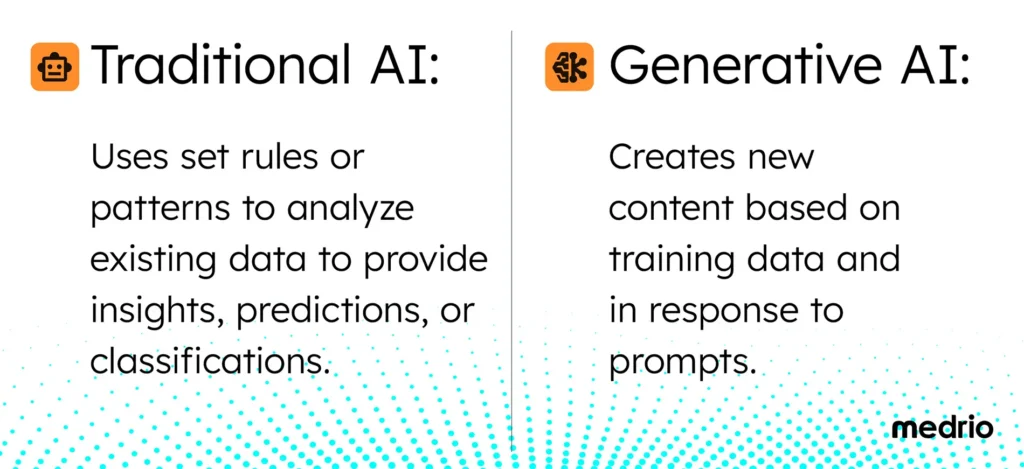
Bias and Fairness
It is important to address bias and ensure fairness in AI systems. This approach is critical to maintain integrity and inclusivity in clinical trials.
Bias refers to systematic errors in AI predictions due to unrepresentative or imbalanced data.
Fairness is the practice of ensuring AI systems produce equitable outcomes across different patient groups. This practice is an essential factor in clinical trials for diverse populations.
Understanding AI Terminology in Clinical Research
Understanding AI terminology is essential for navigating its use in clinical research. This section defines key concepts to help understand AI’s role and potential impact in trials.
Machine Learning (ML)
Machine learning (ML) is a branch of AI and computer science. ML uses data and algorithms to enable AI to imitate how humans learn, gradually improving its accuracy.
Computer systems use ML to refine output functions by learning from input data with little human intervention.
In clinical trials, ML can accelerate data analysis. This function enables faster insights and supports real-time decision-making.
Deep learning
Deep learning is a subset of machine learning. It uses complex neural networks with multiple layers to analyze large volumes of data.
In clinical trials, this technique is particularly useful for image analysis, biomarker discovery, and predictive modeling.
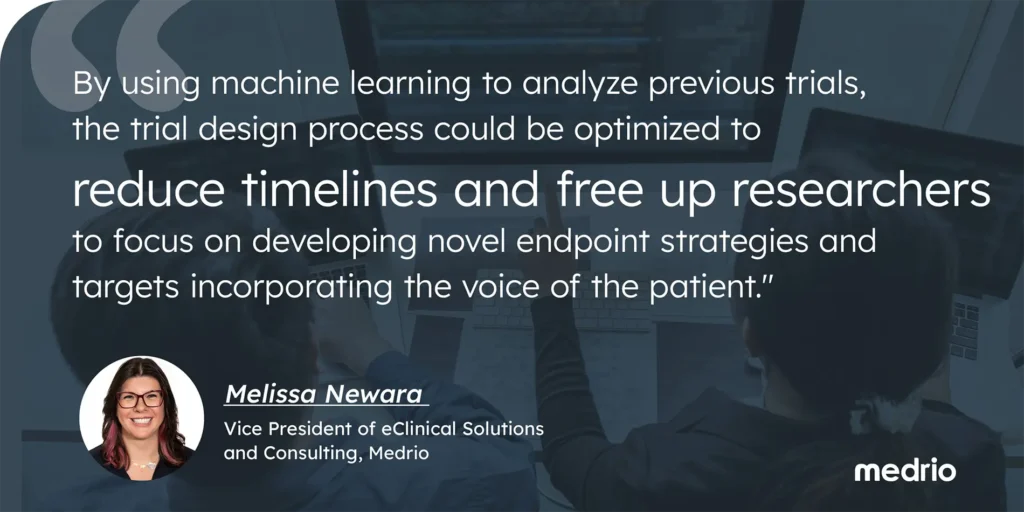
Algorithms and Algorithm Transparency
An algorithm is a set of rules or instructions given to AI, which it uses to learn from data and make decisions. Algorithm transparency refers to the extent to which AI algorithms and their decision-making processes are understandable to humans.
In clinical trials, transparency is crucial for regulatory compliance and for fostering trust among stakeholders.
Federated Learning
Federating learning is a technique where AI models train across multiple decentralized data sources without sharing sensitive data directly.
This technique is beneficial in clinical research. It helps maintain patient privacy while allowing data analysis across diverse trial sites.
Natural Language Processing
Natural Language Processing (NLP) enables AI systems to interpret and generate human language.
NLP in clinical trials is useful for:
- Analyzing unstructured data in clinical records
- Extracting insights from clinical literature
- Enhancing patient recruitment by screening for eligibility criteria in medical histories
Predictive Analytics
Predictive analytics involves using AI and machine learning to forecast future outcomes.
In clinical trials, predictive analytics can forecast trial outcomes, such as patient response or dropout rates. Predictive analytics can help sponsors identify risks early and make proactive adjustments.
Synthetic Clinical Trial Data
Synthetic data is artificially generated data.
In clinical trials, synthetic data mimics real-world patient data without compromising patient privacy. It’s valuable for training AI models without the need for extensive access to sensitive, real-world data.
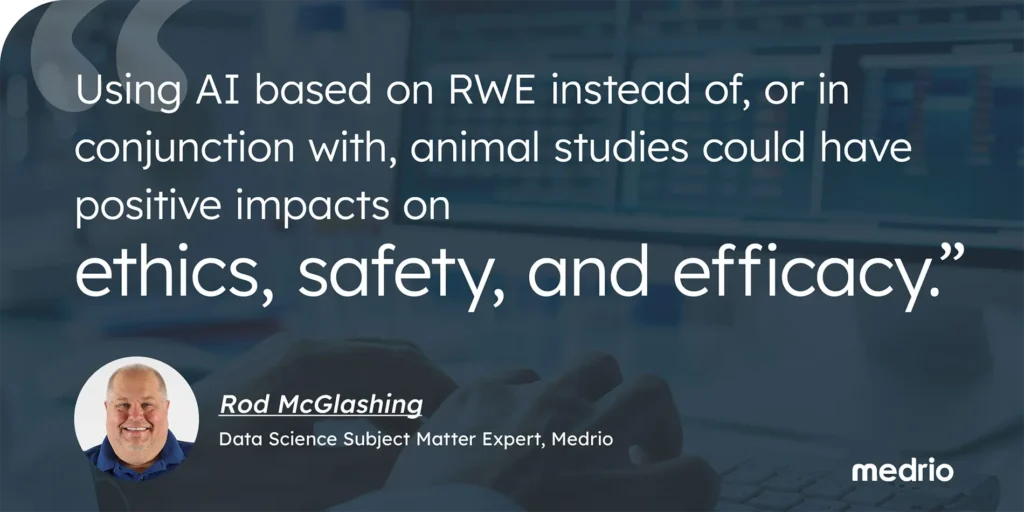
Real-World Evidence
Real-world evidence (RWE) uses data collected from sources outside of controlled clinical trials to inform trial designs and improve patient recruitment. Outside sources can include electronic health records (EHRs) or patient registries.
AI can process RWE to identify patterns that traditional data analysis might miss.
Want to learn more about navigating the changing landscape of RWD, RWE, and Phase IV trials? Download our Real-World Evidence eBook.
What to Know Before Using AI in Your Trial
As AI unfolds at a breakneck pace, clinical research teams need to remain informed about its potential and limitations. Sponsors and CROs who fail to stay updated may miss out on driving better outcomes and potentially reducing time and costs.
For sponsors looking to incorporate AI into their trials, preparation is key:
- Stay current on the latest AI advancements and AI clinical trial regulations.
- Address ethical and regulatory requirements proactively.
- Plan thoroughly and prioritize ongoing education for your team.
- Adopt a human-in-the-loop (HITL) approach for enhanced control and accuracy.
Looking to incorporate AI in your next trial? Make sure you’re asking the right questions with our AI key questions infographic.
Medrio AI Incubator Program
Medrio’s AI Incubator Lab is tackling the challenges of modern trials head-on. It addresses the need for more data, endpoints, and precision.
As part of the program, the product leadership team is working on new tools to enhance speed, quality, and compliance in clinical trials.
Medrio is inviting sponsors, CROs, and industry experts to shape the future of AI in clinical research. Work with us to refine how AI could handle increasing trial data volumes and optimize workflows.
Interested in AI in clinical trials? Join the Medrio AI Incubator Lab.
Frequently Asked Questions About AI Use in Clinical Research
Common questions about AI in clinical research.
How is AI being used in clinical trials?
AI streamlines clinical trials by optimizing protocol design, predicting outcomes, and analyzing big datasets. It can aid participant recruitment by matching eligible patients to trials. Also, AI can enhance safety monitoring with real-time alerts for adverse events. It may also improve efficiency in data management and support decision-making with advanced predictive models.
How is Gen AI used in clinical trials?
Generative AI could create synthetic patient data to train models without privacy concerns. It could also draft trial documents like protocols or reports. Gen AI could also simulate patient scenarios, helping researchers predict trial outcomes.
Will AI replace clinical researchers?
AI will not replace clinical researchers but could augment their work. Researchers remain essential for interpreting AI outputs, validating results, and making decisions. Human oversight ensures ethical compliance, contextual understanding, and patient safety. AI is a tool to enhance, not substitute, human expertise in trials.
What are the challenges of AI in clinical trials?
AI in clinical trials faces challenges like algorithm bias, data privacy concerns, and regulatory compliance issues. Models must be transparent and interpretable to ensure trust. Using AI requires robust infrastructure and researcher training. Additionally, oversight is essential to avoid errors and ensure ethical and equitable AI applications in healthcare settings.
What are the ethics of AI in clinical trials?
AI ethics in clinical trials focus on ensuring patient privacy, addressing algorithm bias, and maintaining transparency in decision-making. Researchers must ensure equitable outcomes for all participants. Ethical AI use requires strict adherence to data security standards. Oversight is crucial to validate AI predictions and maintain trust while balancing innovation with patient safety.
Contributing Experts at Medrio: Amy Fasiczka, ePRO Solutions Design Architect; Cameron Kinnear, Principal Solutions Consultant; Ian Davison, RTSM Subject Matter Expert; Melissa Newara, Vice President of eClinical Solutions and Consulting; Mike Stocks, Chief Technology Officer; Rod McGlashing, Data Science Subject Matter Expert; and Tina Caruana, Director of eClinical Solutions



